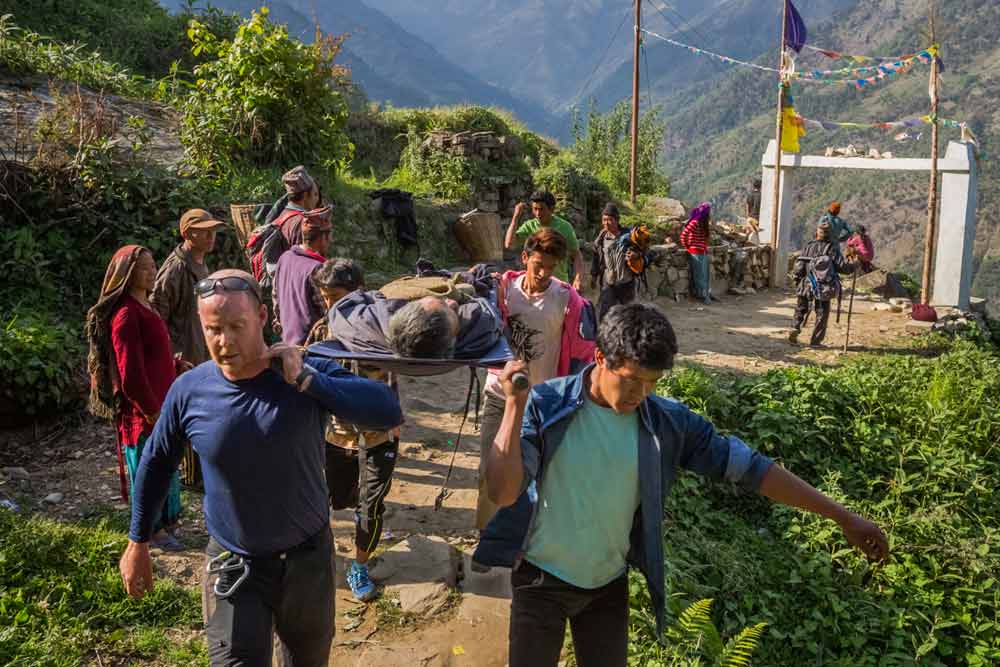
Earthquakes in
Nepal
International Medical Corps Helps Nepal from Relief to Self-reliance
The 7.8-magnitude earthquake that rocked Nepal on Saturday, April 25 caused enormous devastation throughout the country. International Medical Corps was among the first international NGOs on the ground operating following the earthquake providing lifesaving medical treatment and supplies. The response has now transitioned to focus on recovery and International Medical Corps is working to provide orthopedic and rehabilitative care to injured people, is working with local partners to provide psychosocial support, is improving health care and gender-based violence services for women and girls and is providing nutrition projects and water, sanitation and hygiene interventions.
International Medical Corps was on the ground when the first earthquake struck on April 25th and our Emergency Response Team was deploying Mobile Medical Units (MMUs) to some of the hardest-hit locations in Nepal, providing lifesaving medical care within the next 48 hours. In total, our MMUs reached 27 remote villages via car and helicopter and provided more than 4,500 primary healthcare consultants.


8,800 people
were killed and another 22,300 were injured
32,500 people
people have access to services through our physical therapy center in Gorkha
567 people
trained on psychological first aid for first responders
Recovery & Training

Recovery
International Medical Corps is now focused on the recovery process: what the hardest-hit communities require to get back on their feet, and once again become self-reliant. Our recovery efforts in Nepal’s earthquake-affected communities include:
- Reconstructing health posts in earthquake-affected areas.
- Providing rehabilitation services to people who sustained orthopedic injuries – International Medical Corps operates the first-ever physiotherapy unit in Gorkha and mobile physical therapy units that provide assistance in remote areas for people unable to travel to Gorkha.
- Addressing the mental health and psychosocial support (MHPSS) needs of earthquake-affected people and those with pre-existing mental health conditions. International Medical Corps is working closely with a local partner NGO, TPO Nepal, to train participants in psychosocial issues.
- Rebuilding food security to prevent malnutrition among earthquake‐affected communities, including cash support and the provision of seeds and tools to affected populations;
- Supporting pregnant women and new mothers with reproductive health care services; and
- Improving water, sanitation, and hygiene conditions (WASH) in earthquake‐damaged areas including building latrines, distributing urgently needed supplies and conducting large scale hygiene education programs to thwart the spread of deadly disease.

Training
International Medical Corps is also working to ensure lifesaving skills are passed on through training. For example:
- We’re supporting trainings for paramedics for the Nepal Ambulance Service, which is a vital lifeline, as there is no pre-hospital emergency care system in Nepal.
- And we are supporting crucial training to help local health care workers better respond to reproductive health needs, and we’re supporting trainings on the clinical management of rape.
- International Medical Corps has partnered with local organizations in Nepal to address mental health needs of earthquake-affected people, as well as individuals with pre-existing conditions. We train healthcare workers in the delivery of mental health services and orientation sessions for front line health workers.
Crushed by a landslide: Nepal earthquake survivor starts journey home four months later
Imagine being discharged from a hospital after four months of recovery. Now, picture having to scale the precipitous mid-hills of Nepal—real mountains—for seven days before you can get home. As bizarre as it may sound, this was the predicament one Nepali man found himself in as he prepared to leave Gorkha Hospital and International Medical Corps’ Physiotherapy Unit, where he had spent the last few months recovering from multiple orthopedic fractures.
READ MORE